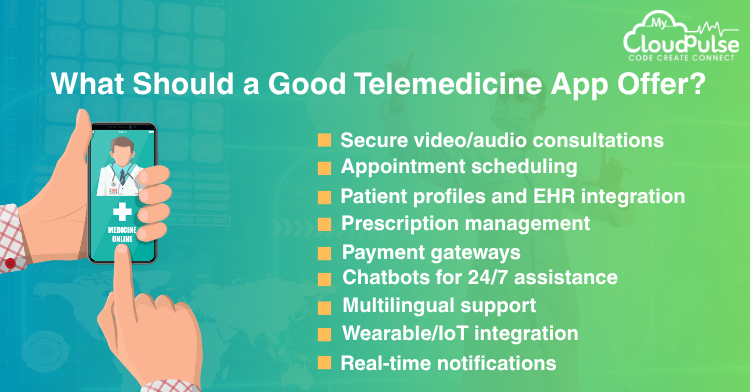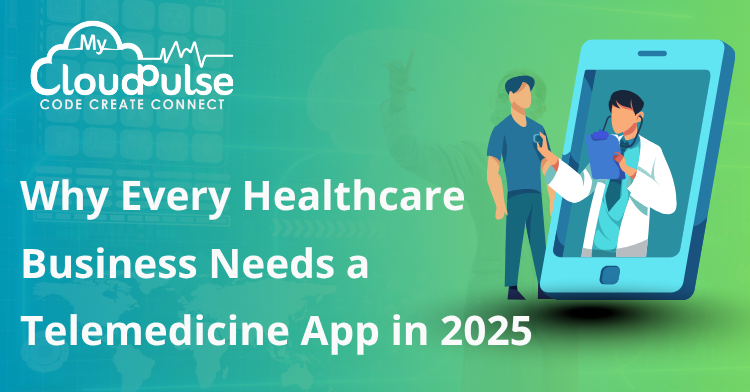Telemedicine is no longer optional — it’s essential. What began as a pandemic response is now a cornerstone of modern care. In 2025, every healthcare business needs a telemedicine app to stay relevant, accessible, and future-ready.
As we step into 2025, telemedicine apps are no longer optional; they’re a strategic necessity for every healthcare business looking to stay relevant, scalable, and patient-centric.
In this blog, we’ll explore why every healthcare provider — from clinics and hospitals to individual practitioners — must embrace telemedicine app development in 2025 and how this technology is shaping the future of care delivery.
The Rise of Telemedicine: A Quick Recap
elemedicine refers to the remote diagnosis, consultation, and treatment of patients via telecommunications technology. Though it’s been around for decades, the COVID-19 pandemic dramatically accelerated its adoption. Patients, once hesitant to consult doctors online, quickly adjusted to the convenience and safety of virtual care. That’s why every healthcare business needs a telemedicine app in 2025 to meet evolving patient expectations and stay ahead in the digital healthcare landscape.
As of 2024:
- Over 80% of healthcare providers in developed countries offer some form of telemedicine.
- Telehealth usage is 38x higher than pre-pandemic levels (Source: McKinsey).
- The global telemedicine market is projected to reach $460 billion by 2030.
Clearly, this is not just a passing trend — it’s the new normal.
1. Shifting Patient Expectations in the Digital Age
Today’s patients expect the same convenience from healthcare as they do from banking or shopping. They want:
- Instant access to medical professionals
- Remote consultations from the comfort of home
- Digital prescriptions and medical records
- Reduced waiting times and travel
Healthcare businesses that offer these features via a dedicated telemedicine app enjoy higher patient satisfaction, retention, and trust. Those who don’t? They risk becoming obsolete.
In 2025, digital-first healthcare is not a luxury — it’s a demand.
2. Expanding Reach and Accessibility
Telemedicine breaks down geographical barriers, allowing healthcare providers to reach patients in:
- Remote rural areas with limited medical infrastructure
- Underserved populations with mobility or transportation issues
- Regions affected by natural disasters or conflict zones
With a telemedicine app, your clinic or practice is no longer bound by a physical location. You can scale your services nationally — or even globally — at a fraction of the cost.
This increased accessibility also contributes to public health equity, aligning your brand with social responsibility while growing your business.
3. Increased Operational Efficiency and Cost Savings
Telemedicine apps automate and streamline many routine processes, including:
- Appointment scheduling
- Patient registration
- Billing and invoicing
- EHR (Electronic Health Records) integration
- Prescription management
This allows healthcare businesses to operate with leaner teams, fewer administrative errors, and reduced overhead costs.
In fact, a 2023 report by Deloitte revealed that healthcare organizations using telemedicine apps saw a 25-35% decrease in operational expenses within the first year of implementation.
4. Better Chronic Disease Management
Chronic conditions like diabetes, hypertension, and asthma require continuous monitoring and regular check-ins. With a telemedicine app, patients can:
- Share vitals and symptoms in real-time
- Receive timely medication adjustments
- Avoid unnecessary hospital visits
- Stay engaged with their treatment plan
Healthcare businesses that offer such services foster long-term patient relationships, reducing rehospitalizations and improving health outcomes — a win-win for both providers and patients.
5. Integration With Wearables and IoT
The popularity of wearable health tech like smartwatches, fitness bands, and medical sensors is skyrocketing. When integrated with telemedicine apps, these devices allow:
- Real-time health tracking (heart rate, blood sugar, oxygen levels)
- Data-driven diagnoses
- Personalized treatment plans
For healthcare businesses, this unlocks a treasure trove of patient data, enabling proactive and preventive care.
In 2025, the fusion of IoT and telemedicine will define how we detect and treat diseases — early, accurately, and remotely.
6. Compliance With Healthcare Regulation
Modern telemedicine apps are built to adhere to strict data privacy and security protocols such as:
- HIPAA (USA)
- GDPR (Europe)
- NDHM guidelines (India)
- PIPEDA (Canada)
By investing in a custom telemedicine app that’s regulation-compliant, healthcare businesses can confidently avoid legal pitfalls, cyber threats, and penalties — while building trust and transparency with patients.
7. Competitive Advantage in a Saturated Market
Let’s face it: healthcare is a competitive space. Patients today have plenty of choices. A telemedicine app can:
- Differentiate your brand
- Attract tech-savvy younger demographics
- Enable loyalty programs and health memberships
- Provide personalized care experiences
Whether you’re a multi-specialty hospital or a small private practice, a well-designed telemedicine platform can position you as an innovator in your field, gaining market share in a crowded ecosystem.
8. Flexibility and Work-Life Balance for Providers
Doctors, nurses, and therapists also benefit from telemedicine. By reducing in-person appointments, providers can:
- Serve more patients in less time
- Work from home or multiple locations
- Manage flexible hours
- Reduce burnout
In 2025, healthcare businesses that support provider wellbeing will enjoy lower turnover, happier teams, and better care quality.
9. Emergency and Follow-Up Care Made Easy
Not all health issues require a trip to the ER. Through a telemedicine app, patients can:
- Get medical advice instantly
- Perform post-operative check-ins
- Follow up on lab reports
- Adjust medications
This not only eases the burden on emergency departments but also ensures continuous care, improving outcomes and building patient loyalty.
10. Data-Driven Insights and AI-Powered Diagnostics
With advancements in AI and machine learning, telemedicine apps can now:
- Auto-analyze symptoms
- Suggest preliminary diagnoses
- Flag high-risk cases for urgent review
- Provide chatbots for initial triage
For healthcare businesses, this means faster workflows, better decision-making, and smarter resource allocation.
In 2025, the integration of AI into telemedicine platforms will be a standard, not a bonus.
Real-World Success Stories
1. Mayo Clinic
Mayo Clinic’s digital health ecosystem includes virtual care, symptom checkers, and AI-driven tools. Their telemedicine program saw a 300% increase in patient visits between 2020 and 2023.
2. Practo (India)
Practo’s app connects patients with verified doctors across 25+ specialties. In 2024 alone, they facilitated over 2 million online consultations.
3. Teladoc Health (USA)
One of the largest telehealth providers globally, Teladoc has helped millions with chronic condition management, mental health support, and general care — all remotely.
These case studies show that scalability, profitability, and quality care are not mutually exclusive in telemedicine — they go hand in hand.
What Should a Good Telemedicine App Offer?

To stay ahead in 2025, a robust telemedicine app should include:
- Secure video/audio consultations
- Appointment scheduling
- Patient profiles and EHR integration
- Prescription management
- Payment gateways
- Chatbots for 24/7 assistance
- Multilingual support
- Wearable/IoT integration
- Real-time notifications
Custom development allows you to tailor the features to your specific practice needs — whether you’re a dermatologist, pediatrician, psychiatrist, or physiotherapist.
Challenges to Be Aware Of
While the benefits are undeniable, telemedicine does come with challenges:
- Digital literacy among elderly patients
- Network issues in rural areas
- Initial development and integration costs
- Licensing laws for cross-border consultations
However, these hurdles are being addressed through government support, better UX design, and scalable cloud infrastructure.
The earlier your healthcare business adopts telemedicine, the smoother your transition will be.
Final Thoughts: The Future Is (Virtually) Here
The future of healthcare is not just coming — it’s already here, in the form of telemedicine. And in 2025, telemedicine apps will no longer be a competitive edge — they’ll be a survival tool.
From improving accessibility and operational efficiency to boosting patient satisfaction and enabling cutting-edge diagnostics, a telemedicine app is the key to helping healthcare businesses future-proof their services, enhance care delivery, and thrive in a digital-first world — because every healthcare business needs a telemedicine app in 2025.
Don’t wait for the industry to leave you behind. Start planning your telemedicine transformation today.
Frequently Asked Questions (FAQs)
No. Specialists like dermatologists, psychiatrists, gynecologists, and even dietitians use telemedicine to consult patients remotely.
When built with end-to-end encryption and HIPAA/GDPR compliance, telemedicine apps are highly secure for patient data and communication.
Depending on complexity, it ranges from $25,000 to $150,000. However, the ROI is substantial over time due to efficiency and scalability.
Yes. Modern apps can integrate with EHR, billing systems, appointment management tools, and even IoT devices.
Absolutely. Patients today prefer convenience. A user-friendly telemedicine app can significantly increase engagement and satisfaction.



